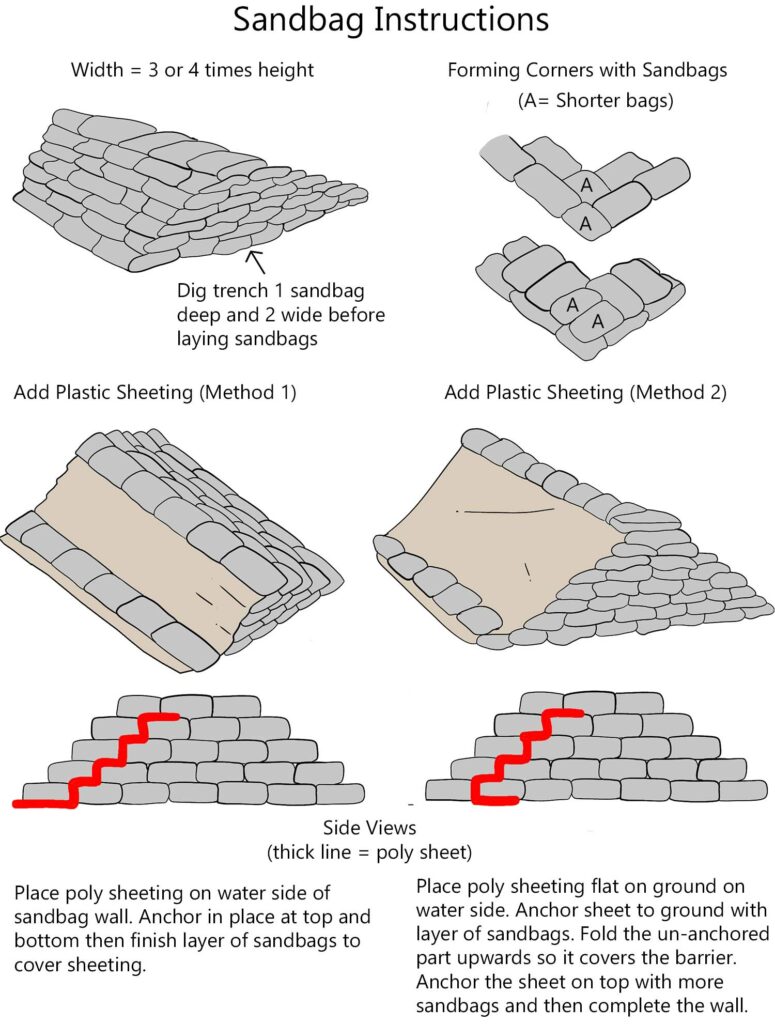If you live in a flood-prone area, knowing how to lay sandbags is essential to your flood preparedness. Here’s what you need to know about sandbags for flood protection, how many sandbags you’ll need, and how to lay sandbags.
Do Sandbag Barriers Actual Work?
When laid properly, sandbags are very effective flood barriers.
However, be warned that filling and laying sandbags is back-breaking work. It takes two people working together to fill sandbags (one for holding the bag and another for filling). Even if you work all day, you may only get 50 sandbags filled. Bear in mind that it takes a lot of sandbags to make a barrier.
Another problem is that you need to have sand for the sandbags. You could put a pile of sand in your yard, but it will eventually compact and start growing plant matter, making it even harder to shovel into sandbags.
Because of these issues, for most people, it isn’t realistic to sandbag around their entire home before a flood warning. Instead, creating a few sandbag barriers to put in strategic places or using other DIY flood barrier methods might make more sense.
Can You Fill Sandbags in Advance?
Many people who live in flood-prone areas will keep a stack of sandbags on hand. However, sandbags break down over time.
If left in the sun, the UV rays will cause the polypropylene material to deteriorate and fall apart in approximately 6 to 8 months. Even if left in a garage or shed, the sandbags might not last more than a year or two.
How Many Sandbags Do You Need?
For a 50 linear foot barrier, you will need:
- 1 foot high/3 layers: 300 bags
- 2 feet high/6 layers: 1050 bags
- 3 feet high/9 layers: 2350 bags
What Types of Bags Can You Use for Sandbags?
It is best to use polypropylene bags for sandbags. Burlap or woven bags can also be used. Plastic and grain bags aren’t recommended but can be used if you have nothing else.
How to Fill Sandbags
- Only fill sandbags ½ to 1/3 full. The sand needs to move around in the bags to create an effective barrier. Full bags simply don’t stack well (imagine stacking balloons).
- Do NOT tie sandbags. Except while transporting them, do not tie sandbags. The sand won’t be able to move around well. If you have to tie them and won’t have time to untie them before laying them, then tie them near the top so the sand can move around.
- Wear gloves and goggles! Don’t skip the goggles, as sand can get in your eyes.

Can You Use Dirt to Fill Sandbags?
It is not recommended to use dirt instead of sand for sandbags. However, in a pinch, you can use dirt or potting soil for sandbags.
How to Lay Sandbags
- Make a trench:
- For small sandbag barriers, remove the sod/grass where you will make your barrier.
- For larger sandbag barriers, dig a trench that is 1 sandbag deep and 2 sandbags wide. Lay sandbags in the trench.
- Laying the sandbags
- Lay the first sandbag with its open end towards the direction of the water flow or uphill.
- Lay the second bag on the flap of the previous bag. Keep laying sandbags in this manner.
- When you get to the end of a row, tuck the bag’s flap underneath it.
- To form corners with sandbags, use shorter bags in the corners.
- Add plastic sheeting:
- Lay poly sheeting on the water side of the sandbag wall you’ve created. Anchor the poly in place with sandbags.
- Complete the wall.


Related
https://fire.lacounty.gov/wp-content/uploads/2019/08/Sandbagging-Instructions.pdf
https://lewiscountywa.gov/departments/emergency-management/flood-information/sandbags-frequently-asked-questions/
https://assets.publishing.service.gov.uk/government/uploads/system/uploads/attachment_data/file/892489/Sandbags-and-how-to-use-them-properly-for-flood-protection.pdf
https://www.gov.mb.ca/emo/pdfs/sandbag.pdf
https://www.reddit.com/r/preppers/comments/ky24pl/does_anyone_have_any_experience_using_sandbags/

